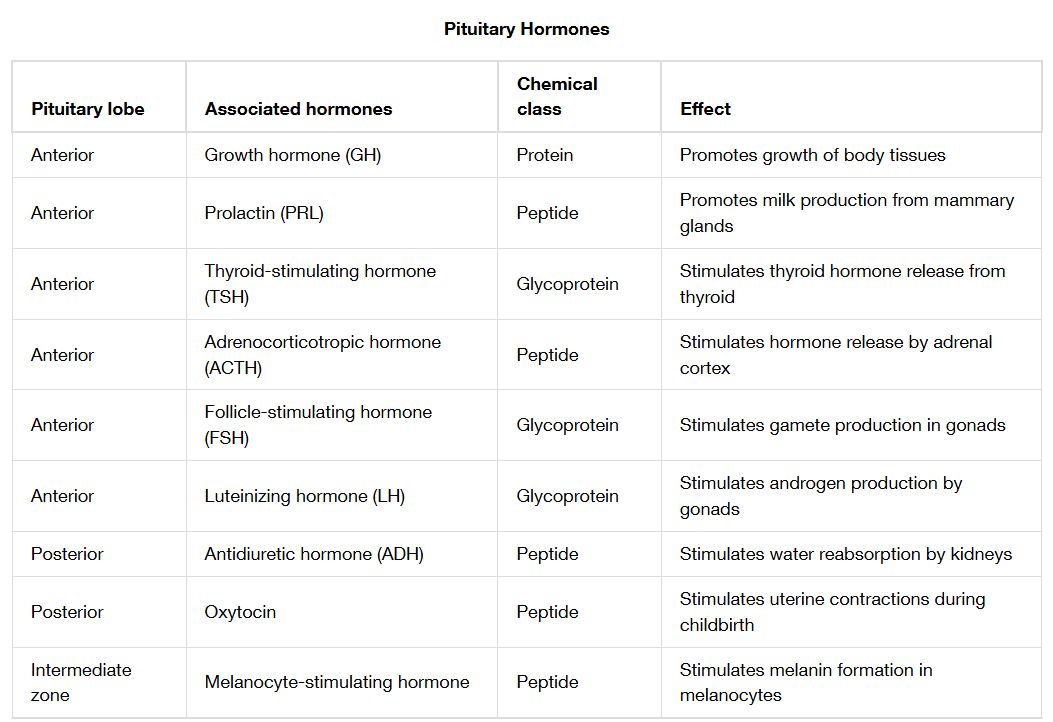The pituitary gland, often dubbed the “master gland,” orchestrates a wide array of bodily functions through the release of key hormones that influence various target organs. This article examines a comprehensive chart detailing the hormones secreted by the pituitary, their release mechanisms, and their physiological effects, providing a clear understanding of this central endocrine regulator.

Anterior pituitary The anterior pituitary produces and releases several hormones that regulate other endocrine glands and bodily processes. It responds to signals from the hypothalamus to maintain hormonal balance.
Posterior pituitary The posterior pituitary stores and releases hormones produced by the hypothalamus, primarily ADH and oxytocin. It acts as a conduit for neural signals to control water balance and reproductive functions.
Growth hormone (GH) Growth hormone (GH) stimulates growth in children and maintains tissue repair in adults by promoting protein synthesis. It is released in pulses, with peak levels during sleep and exercise.
Thyroid-stimulating hormone (TSH) Thyroid-stimulating hormone (TSH) prompts the thyroid gland to produce T3 and T4, regulating metabolism and energy levels. Its secretion is controlled by hypothalamic TRH.
Adrenocorticotropic hormone (ACTH) Adrenocorticotropic hormone (ACTH) stimulates the adrenal glands to release cortisol, aiding in stress response and metabolism. Its release follows a circadian rhythm, peaking in the morning.
Follicle-stimulating hormone (FSH) Follicle-stimulating hormone (FSH) supports gamete production, promoting egg maturation in females and sperm development in males. It works alongside LH to regulate reproductive cycles.
Luteinizing hormone (LH) Luteinizing hormone (LH) triggers ovulation in females and testosterone production in males, driving reproductive processes. Its surge is critical for menstrual and fertility cycles.
Prolactin (PRL) Prolactin (PRL) stimulates milk production in the mammary glands post-pregnancy and can suppress ovulation during lactation. Its release is inhibited by dopamine from the hypothalamus.
Antidiuretic hormone (ADH) Antidiuretic hormone (ADH) regulates water balance by reducing urine output in the kidneys. It is released in response to dehydration or low blood pressure.
Oxytocin (OT) Oxytocin (OT) facilitates uterine contractions during childbirth and milk ejection during breastfeeding. It also plays a role in social bonding and emotional connections.
Target organs Target organs, including the thyroid, adrenals, gonads, and kidneys, respond to pituitary hormones to carry out specific functions. Their activation depends on the hormone type and physiological need.
Effects Effects of pituitary hormones include growth promotion, metabolic regulation, and reproductive support. These outcomes vary based on the target organ and hormone concentration.
Anatomical and Functional Overview
The pituitary gland’s dual structure drives its diverse hormonal roles. This division enables precise control over bodily systems.
- The anterior pituitary synthesizes hormones like GH, TSH, ACTH, FSH, LH, and PRL.
- The posterior pituitary releases ADH and OT, stored from hypothalamic production.
- Target organs respond to these hormones, amplifying their systemic effects.
- The gland’s location at the brain’s base allows close hypothalamic interaction.
- This structure supports a coordinated endocrine response.
Hormone Release Mechanisms
The release of pituitary hormones is tightly regulated by the hypothalamus. This process ensures appropriate hormonal levels for various conditions.
- GH release is pulsatile, influenced by sleep and exercise, targeting growth and repair.
- TSH secretion depends on TRH, stimulating thyroid hormone production.
- ACTH follows a circadian pattern, driving cortisol release for stress management.
- FSH and LH are released in cycles, regulating reproductive functions.
- PRL release is inhibited by dopamine, activating during lactation.
Physiological Effects on Target Organs
Pituitary hormones exert specific effects on their target organs. These actions maintain homeostasis and support development.
- GH promotes bone and muscle growth, with effects mediated by IGF-1.
- TSH increases T3 and T4, boosting metabolic rate and energy use.
- ACTH stimulates cortisol, enhancing stress resilience and glucose metabolism.
- FSH and LH drive gamete maturation and sex hormone production.
- PRL supports lactation, while ADH and OT regulate water and childbirth.
Clinical Relevance and Disorders
Understanding pituitary hormone effects aids in diagnosing related conditions. Imbalances can lead to significant health issues.
- Excess GH can cause acromegaly, characterized by enlarged bones and tissues.
- Low TSH may indicate hypothyroidism, slowing metabolism.
- Overproduction of ACTH leads to Cushing’s syndrome, with weight gain and fatigue.
- FSH/LH imbalances can result in infertility or irregular cycles.
- ADH deficiency causes diabetes insipidus, marked by excessive urination.
The pituitary gland’s hormone releases and their effects form a complex network that governs growth, metabolism, reproduction, and stress response. By influencing target organs through a well-coordinated system, it ensures the body adapts to internal and external changes, offering valuable insights into endocrine health and potential therapeutic approaches.

